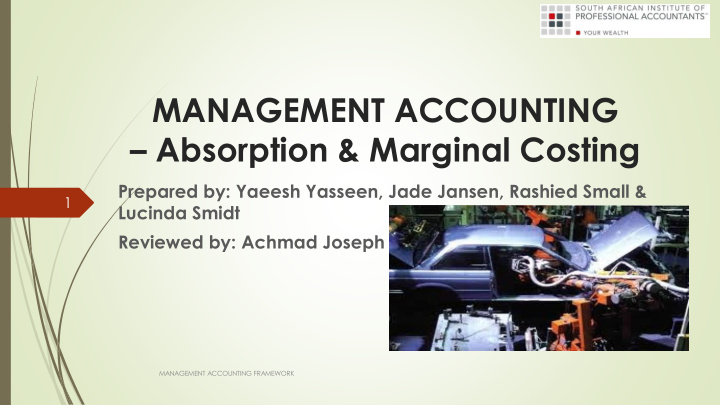



MANAGEMENT ACCOUNTING – Absorption & Marginal Costing Prepared by: Yaeesh Yasseen, Jade Jansen, Rashied Small & 1 Lucinda Smidt Reviewed by: Achmad Joseph MANAGEMENT ACCOUNTING FRAMEWORK
Job & Process Costing 2 2 Job costing: Applied when producing of customized (products with unique features) or different items within the production cycles Process costing: Applied when producing of homogeneous products on a continuous basis over a long period of time MANAGEMENT ACCOUNTING FRAMEWORK
GROUP WORK – ACTIVITY 4: ABRAM 3 [Selection of system – Job vs Process costing] MANAGEMENT ACCOUNTING FRAMEWORK
GROUP WORK – ACTIVITY 4: JOEDINE 4 [Selection of system – Job vs Process costing] MANAGEMENT ACCOUNTING FRAMEWORK
Process Costing Systems 5 Cost object MANAGEMENT ACCOUNTING FRAMEWORK
Allocation of Manufacturing Fixed Costs 6 Allocation of Manufacturing costs: Manufacturing costs are indirect costs and should allocated to the cost object – allocation is based on pre-determined overhead rate. POR = Estimate manufacturing costs Estimated units of allocation basis The allocation basis is the cost driver that cause the manufacturing costs MANAGEMENT ACCOUNTING FRAMEWORK
Basis of Allocation 7 Labour intensive business: Basis of allocation = labour hours Capital intensive business: Basis of allocation = machine hours Mass production business: Basis of allocation = output MANAGEMENT ACCOUNTING FRAMEWORK
Applied of Manufacturing Costs 8 Labour Intensive Capital Intensive Overhead costs 562,500 Overhead costs 562,500 Labour hours 90,000 Machine hours 100,000 Pre-determine overhead rate 6.25 Pre-determine overhead rate 5.625 Actual labour hours 50,000 Actual machine hours 50,000 Applied overhead costs 312,500 Applied overhead costs 281,250 MANAGEMENT ACCOUNTING FRAMEWORK
GROUP WORK – ACTIVITY 5: UNIQUE 9 [Pre-determined overhead rate] MANAGEMENT ACCOUNTING FRAMEWORK
Fixed Cost Allocation 10 MANAGEMENT ACCOUNTING FRAMEWORK
Traditional Service Cost Allocation 11 MANAGEMENT ACCOUNTING FRAMEWORK
Direct Service Cost Allocation 12 Service 1 Service 2 Dept. A Dept. B Total cost 120,000 200,000 250,000 390,000 Dept. A 30% 60% Dept. B 70% 40% Service 1 (120,000) 36,000 84,000 Service 2 (200,000) 120,000 80,000 Product cost nil nil 406,000 554,000 No relationship between service departments – direct allocation to production departments MANAGEMENT ACCOUNTING FRAMEWORK
Step-down Cost Allocation 13 Service 1 Service 2 Dept. A Dept. B Total cost 120,000 200,000 250,000 390,000 Dept. A 30% 60% Dept. B 50% 40% Service 2 20% Service 1 (120,000) 24,000 36,000 60,000 Subtotal 224,000 Service 2 (224,000) 134,400 89,600 Product cost nil nil 420,400 539,600 MANAGEMENT ACCOUNTING FRAMEWORK
Reciprocal Service Cost Allocation 14 Service 1 Service 2 Dept. A Dept. B Total cost 120,000 200,000 250,000 390,000 Dept. A 30% 40% Dept. B 60% 40% Service 1 20% Service 2 10% Product cost MANAGEMENT ACCOUNTING FRAMEWORK
Activity Based Costing 15 Activity-based costing (ABC) is a costing methodology that identifies activities in an organization and assigns the cost of each activity with resources to all products and services according to the actual consumption by each. MANAGEMENT ACCOUNTING FRAMEWORK
GROUP WORK – ACTIVITY 6: DOLSAL 16 [Allocation of Service Cost] MANAGEMENT ACCOUNTING FRAMEWORK
Product Costing 17 MANAGEMENT ACCOUNTING FRAMEWORK
Absorption & Marginal Costing 18 ABSORPTION COSTING MARGINAL COSTING MANAGEMENT ACCOUNTING FRAMEWORK
Absorption & Marginal Costing 19 Cost Absorption Marginal Direct material costs 25.00 25.00 Direct labour costs 10.00 10.00 Variable overhead costs 3.00 3.00 Fixed overhead costs 5.00 - Product cost 43.00 38.00 MANAGEMENT ACCOUNTING FRAMEWORK
Overhead Absorption Rate 20 OAR = Budgeted fixed overhead costs . Estimated normal production capacity OAR must reflect the allocation of fixed operating costs under normal business activities MANAGEMENT ACCOUNTING FRAMEWORK
Under/Over Absorbed Overhead Costs 21 Under Actual Allocated /over overhead overhead absorbed costs costs costs Allocated costs represents the flexible budgeted cost based on the actual level of output MANAGEMENT ACCOUNTING FRAMEWORK
Under/Over Absorbed Costs 22 MANAGEMENT ACCOUNTING FRAMEWORK
GROUP WORK – ACTIVITY 8: DAYAN Mnf 23 [Under/over absorbed costs] MANAGEMENT ACCOUNTING FRAMEWORK
Reconciliation of Profit 24 MANAGEMENT ACCOUNTING FRAMEWORK
Reconciliation of Profit 25 The OAR was R 5.00 and the variable production costs were R 25.00. The actual production was 100,000 units of which 20,000 were unsold; and the total fixed production costs of R 480,000. Absorption Marginal Sales (selling price of R 50,00) 4,000,000 4,000,000 Variable production costs 2,500,000 2,500,000 Fixed production costs (applied) 500,000 NIL Inventory on hand (R 30,00 & R 25.00) (600,000) (500,000) Gross profit 1,600,000 2,000,000 Manufacturing costs NIL 480,000 Over absorbed costs (500,000 – 480,000) 20,000 NIL Profit 1,620,000 1,520,000 OAR including in inventory (20,000 x 5) 100,000 MANAGEMENT ACCOUNTING FRAMEWORK
Reconciliation of Profit 26 MANAGEMENT ACCOUNTING FRAMEWORK
Absorption & Marginal Costing 27 MANAGEMENT ACCOUNTING FRAMEWORK
GROUP WORK – ACTIVITY 7: RETRIX 28 [Application of Absorption & Marginal costing] MANAGEMENT ACCOUNTING FRAMEWORK
GROUP WORK – ACTIVITY 7: BOKSTORM 29 [Application of Absorption & Marginal costing] MANAGEMENT ACCOUNTING FRAMEWORK
Wastages in Production 30 MANAGEMENT ACCOUNTING FRAMEWORK
Wastages in Production 31 MANAGEMENT ACCOUNTING FRAMEWORK
Recommend
More recommend